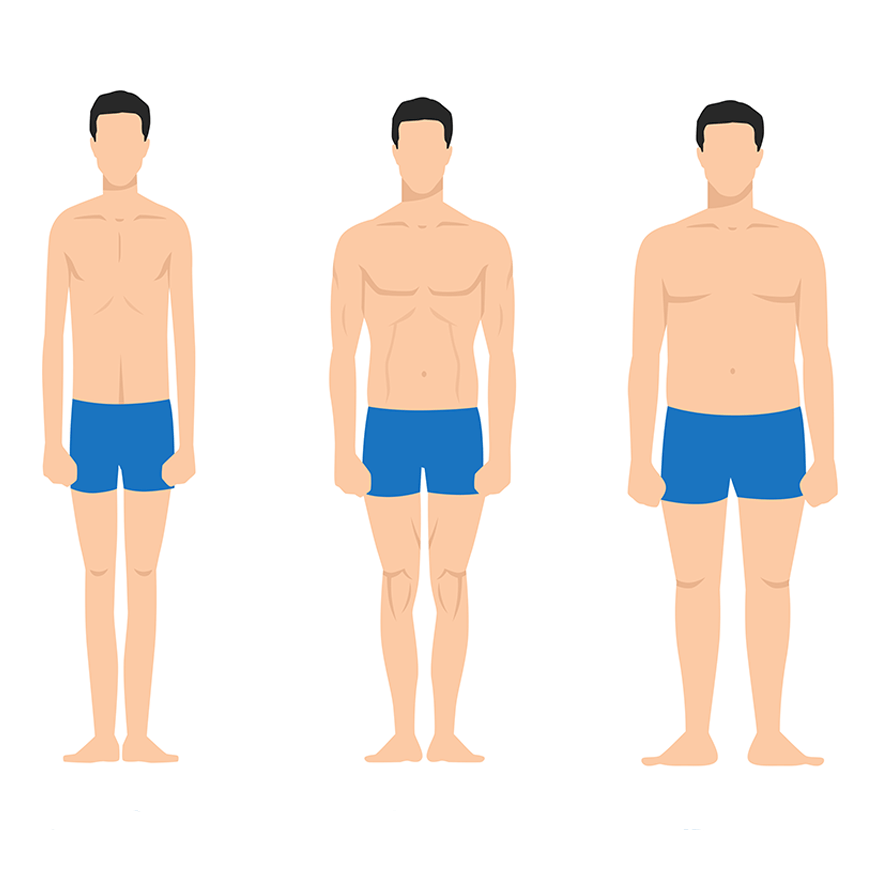There are over eight billion people in the world. Yet, according to William H. Sheldon’s theory, only three extreme body types exist.
Most of us have come across the terms endomorph, mesomorph and ectomorph, whether via a science book in school or through a YouTube video.
Sheldon’s terms fall under the psychological term somatotype, the idea that the human body shape and physique type are linked to personality traits, forming the basis of constitutional psychology.
While the original association of these body types to personality traits and criminal behavior has been debunked, these three body types are still used within the fitness and health sphere today.
Humans come in endless amounts of shapes and sizes. While it could be seen as outdated to categorize everyone into three areas, it’s essential to understand what training and nutrition will maximize your physical and nutritional potential.
After all, if we all followed the same diet and fitness routine, no two people would look or feel the same.
What is body type theory?
William Herbert Sheldon Jr. was born on November 19, 1988, in Warwick, Rhode Island, and would be a pioneering figure in medicine and psychology.
After completing and receiving a Bachelor of Arts degree from Brown University in 1920, he pursued further education at the College of Physicians and Surgeons at Columbia University, where he collected his Doctor of Medicine degree five years later.
Heavily influenced by Ernst Kretschmer – who used a similar classification of body types in his research – Sheldon proposed that three major human personality traits trace directly to each of the three human body types.
After meticulously analyzing a collection of around four thousand photographs featuring college-age men in modest yet minimal clothing, Sheldon arrived at a compelling realization.
He discerned that three key components played a significant role in each individual’s physique, which was captured from various angles, including front, side, and back views.
This led him to postulate a potential correlation between these components and the three developmental layers of the human embryo: the endoderm, mesoderm, and ectoderm.
Per this hypothesis, he attributed Endomorphy, Mesomorphy, and Ectomorphy to these three essential elements that he believed contributed to the entirety of human physiques.
Initially, the prevailing notion held that an individual’s somatotype remained constant and immutable, potentially influencing specific physiological and psychological attributes aligned with each type.
Sheldon’s classification posited that individuals categorized as endomorphs consistently possessed rounded and soft bodies, while mesomorphs invariably exhibited square and muscular physiques. On the other hand, ectomorphs always displayed thin and delicate bone structures.
What is the body type spectrum?
So, why delve into this topic at all?
While the idea of innately predetermined body composition may seem implausible in the context of the 21st century, numerous physiological indicators and observations linked with each somatotype manifest within the broader population.
However, the contemporary perspective has shifted from Sheldon’s initial hypothesis. It’s now understood that our current somatotype is shaped by our physiological attributes rather than vice versa, as he proposed.
In reality, no individual neatly fits into a single somatotype category. Instead, we all exist along a dynamic continuum, continually evolving and occupying a unique position on the spectrum that encompasses all three somatotypes.
What are the three main body types?
Identifying your primary body type can be accomplished by observing specific physical characteristics when you look in the mirror, while another practical approach is reflecting on your childhood or adolescent years.

This retrospective analysis is valuable because it provides insight into your initial body type, which may align more with your body’s natural tendencies before years of dietary and exercise choices.
Endomorph
Regrettably, individuals with endomorph body types may perceive themselves as disadvantaged compared to the other somatotypes.
Endomorphs naturally possess a thicker, heavier, and rounder physique due to their slower metabolism, making weight gain more likely and weight loss more challenging. It’s important to note that while additional weight gain can include muscle, the rapid accumulation often involves fat rather than muscle tissue.
Consider the characteristics listed below to determine if you fall within the endomorph category. While not all attributes need to align, you likely possess an endomorph body type if most resonate with you.
Body Composition:
- Naturally fat or chubby
- Large bone structure
- Natural strength with moderate muscle
- Wide hips with narrow shoulders
- Square torso
Metabolism:
- Slow metabolism
- Easy to gain weight (usually in the form of fat)
- Hard to lose fat
Lifestyle:
- Always hungry
- Eats large meals
- Hard to control hunger
- Daily activity is more sedentary
Mesomorph
Arguably the most sought-after physique, mesomorphs are fortunate to possess a robust initial base for muscle development, which they can enhance more readily when compared to the other two body types.
You might easily recall the individual from your childhood who was consistently muscular, strong, and lean – likely, this person was predominantly a mesomorph. This body type appears to have acquired the positive attributes of both ectomorphs and endomorphs without the accompanying drawbacks.
If you’re lucky to be a mesomorph, many of the following descriptors will apply.
Body composition:
- Naturally lean and muscular
- Normal to large bone structure
- Broad shoulders with a narrow waist
Metabolism:
- Normal to very efficient metabolism
- Easy to gain muscle and strength
- Easy to lose fat
Lifestyle:
- Eats a more consistent diet in terms of quantity and frequency
- Usually good at sports and exercise
Ectomorph
If you’re one of those individuals who can consume a vast array of foods without witnessing substantial weight gain, you could belong to the ectomorph category. This characteristic presents advantages and disadvantages, depending on whether you prefer to maintain a slender physique or aim to build muscle.
Although ectomorphs may be able to indulge in less healthy foods without significant weight increases, they often encounter challenges when attempting to gain muscle mass.
Curious if you align with the ectomorph body type?
Take a glance at the characteristics outlined below. While you might not align with every trait, if the majority resonates with you, chances are that this is your dominant body type.
Body Composition:
- Lean and lanky
- Little muscle mass
- Narrow hips and shoulders
Metabolism:
- Fast metabolism
- Hard to gain weight (especially muscle)
- Quick to lose fat and/or muscle
Lifestyle:
- Eats smaller meals spaced throughout the day
- Long distance/time activities
- Grueling, high-intensity workouts
How should Endomorphs eat and train?
The primary objective for endomorphs commonly revolves around fat loss. Once the desired level of fat loss is achieved, the focus typically shifts to muscle gain.
This dual goal can present a challenge, as shedding fat requires a caloric deficit, while building muscle necessitates a caloric surplus.
When consuming more calories than your body expends, it’s crucial to prioritize clean eating and avoid excessive carbohydrate intake.
Diet
In terms of nutrition, embrace a diet that centers on clean, unprocessed foods, leaving behind junk food.
Intermittent fasting could be a beneficial approach, where you limit your eating window. The 16:8 method, popularly chosen, allows for up to eight hours of fasting time during sleep. With limited calorie intake, make thoughtful food choices and avoid calorie-rich drinks like water, black coffee, or tea.
You aim to derive a significant portion of your calories from protein and fat while moderating carbohydrate intake, striving for 1.5 grams of protein per pound of body weight, which can contribute to a prolonged feeling of fullness.
Cardio
Firstly, initiate aerobic cardio sessions 2-3 times a week, maintaining a moderate to intense intensity, and commit to at least 30-minute sessions.

As your body adapts to regular exercise, consider incorporating intense interval training around three times a week – varying from five to 20 minutes – ensuring that you challenge yourself effectively.
Training
For mesomorphs, tailor your workout programs toward high-volume resistance training, incorporating brief rest periods between exercises and aiming for a rep range of 10-20.
Begin with full-body workouts that target major muscle groups, conducting these sessions three times a week; then, once you progress, you can transition to more specialized workout plans.
Remember, proper hydration during exercise sessions is crucial whether to engage in cardio or resistance training.
How should Mesomorphs eat and train?
Mesomorphs are fortunate to possess a well-proportioned body composition and a metabolism that works efficiently. This advantage often means they can achieve their fitness goals more quickly than others.
Despite the innate advantages of mesomorphs, it’s still essential to adhere to specific guidelines and tips to maintain peak performance. Here are a few general rules to consider.
Diet
Mesomorphs enjoy some flexibility when it comes to their dietary choices. A straightforward principle is to avoid consuming unhealthy foods over several meals or days. Instead, focus on maintaining a regular eating schedule that suits your needs.
Cardio
As shedding fat comes relatively quickly for mesomorphs, their cardio routine can incorporate a blend of steady-state and high-intensity exercises.

Consider engaging in activities like treadmill walking or stationary biking for around 30 minutes at a moderate pace 2-3 times a week. Additionally, integrate two 20-minute high-intensity interval training sessions (HIIT) into your weekly schedule.
Training
When structuring workouts for mesomorphs, it’s essential to tailor them to your particular objectives. Seek out training programs that align with your desired outcomes and commit to following them.
Opt for programs spanning 8-12 weeks, focusing on goals such as achieving targeted muscle gain, enhancing your one-rep max, or attaining a lean physique for the summer season.
How should Ectomorphs eat and train?
Individuals primarily falling into the ectomorph body type category typically exhibit a fast metabolism and a lean, elongated physique, making gaining muscle and fat quite challenging.
Ectomorphs aim to increase muscle mass, so the most effective training routines should prioritize hypertrophy and strength development.
While some might envy the ectomorph’s ability to consume calorie-dense foods without packing on excess weight, their primary objective is often centered around building and maintaining muscle mass.
Counteracting their highly efficient metabolism, ectomorphs must consume a higher-calorie diet than the other two body types.
Diet
Ectomorphs can indulge in some of the most delectable foods without the concern of excessive calorie intake. Aim for whole, calorie-dense foods rich in protein, like peanut butter, whole milk, and occasionally even mass gainers if struggling to meet calorie requirements.
Cardio
If you’re aiming for a combination of cardio and resistance training, choose steady-state cardio that offers cardiovascular benefits without excessively burning calories.

Engage in a 15-to-20-minute walk or other light cardio exercises a few times weekly.
Training
For Ectomorphs, designing workout routines to focus on increasing muscle size (hypertrophy) or gaining strength is vital.
For beginners, it’s crucial to master basic techniques and proper form before progressing to compound lifts. Aim for rep ranges of 3-12, keeping your workouts brief and not exceeding an hour.
Ensure sufficient rest between sets to safely push yourself with heavier weights.






